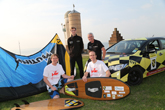 World's first extreme sports university course harnesses manufacturing efficiencies of Stratasys 3D printing technology to enable production of one-of-a-kind kitesurfing board
World's first extreme sports university course harnesses manufacturing efficiencies of Stratasys 3D printing technology to enable production of one-of-a-kind kitesurfing board
Stratasys Ltd. (Nasdaq:SSYS), a leading global provider of 3D printing and additive manufacturing solutions, today announced the use of Stratasys' Fortus 3D Production System for the production of unique kitesurfing boards to be used in a record-breaking land vs. sea challenge this week.
Harnessing the power of both sea and wind, five kite-surfers will attempt to cross the Bristol Channel in a world's first, while their competitors aim to reach the same destination overland in a standard Japanese hybrid car.
The challenge sees the team use their product design expertise to completely re-design and manufacture one-of-a-kind kitesurfing boards using 3D printing for greater control, speed and technical reliability.
3D printed parts include newly designed board fins, with the team having adapted their size, shape, angles and fixings to better suit the sea and wind characteristics. Wrapped in carbon fibre for stiffness, the 3D printed fins are considerably lighter than traditionally manufactured parts, enabling the team to travel at increased speeds as they take on their land opponent. The kite-surfers also used 3D printed inserts to attach the foot straps to the board, designed to achieve the maximum strength possible as they are glued into the foam core.
Ross Head, Product Design Manager for Cerebra at the University of Wales TSD Swansea, and one of the challenge kite-surfers, comments: "The use of 3D printing in product design, and especially in the extreme sport market, is revolutionising the manufacturing process and the speed to which companies can bring new products to market. We wanted our students to witness this first hand."
The challenge is designed to promote the University of Wales, TSD Swansea, and its world first extreme sports engineering design course. The project aims to inspire current and potential students as to the potential of cutting-edge design and manufacturing processes, and better prepare them for the commercial market and future successful careers.
Ross continues: "Stratasys 3D printing was essential to our ability to undertake this project at all. We would literally design, 3D print, fit and test the parts on the boards - all in one day. We would then tweak the designs as necessary and have another set of parts 3D printed overnight. The fact that we could 3D print end-use parts that could perform in the harsh sea environment, quicker and cheaper than any other manufacturing process, takes product development to a new and higher level for us."
The team 3D printed their parts on two Stratasys Fortus 250mc 3D Production Systems in collaboration with Stratasys reseller, Laser Lines. Utilising the systems' ability to pair fine layer resolution with a large build envelope, the kite-surfers were able to fine-tune their designs and quickly print final parts for faster, more effective product testing and development.
"We redesigned the boards' fins using a quad configuration with parts 3D printed using PC-ABS. These new fins provide us with improved lateral grip in the water and the ability to make quick turns. On the underside of the boards, we also designed a very flat rocker line, which means that the boards plane easily and achieve much higher speeds. When you put all of these improvements together, they contribute towards considerable performance gains," explains Ross.
The kite surfing challenge is planned to take place this week, with a successful channel-crossing expected to take roughly three hours. To be competitive, the team calculate that they need a sea state of five or less and a wind speed of 20 knots. If they get these conditions, then it would be possible to beat the auto team driving the University's hybrid Honda Civic, which will contend with local Devon country roads and traffic.
While students did not partake in the design of the equipment for this challenge, should the project be a success, the university plans to roll-out similar student projects in the future, where they will be encouraged to explore their creativity.
Ross concludes: "We are very excited about what 3D printing means for our industry and our course - essentially, anything our students can dream up can be made reality. I predict that 3D printing will play a huge role in the design and development of almost all final year projects for many years to come."
Simon Brandon, Marketing Manager for the UK, Scandinavia, Benelux at Stratasys, concludes: "We are seeing more and more educational establishments embrace 3D printing within the curriculum. This is a great example of a university equipping the engineers of the future with the skills to push the boundaries to new possibilities using Stratasys technology."
www.stratasys.com


















































































